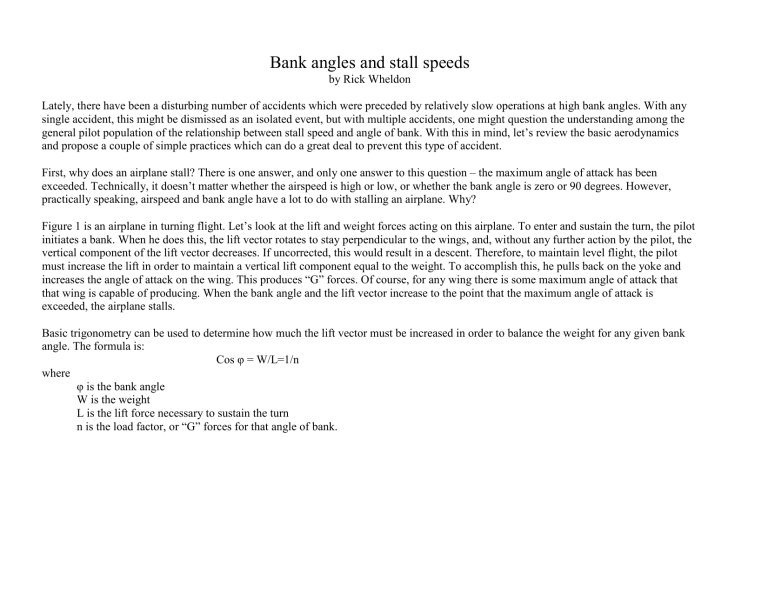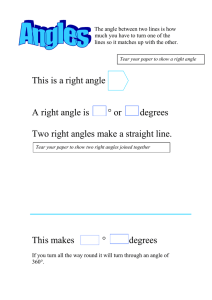Bank angles and stall speeds

Bank angles and stall speeds
by Rick Wheldon
Lately, there have been a disturbing number of accidents which were preceded by relatively slow operations at high bank angles. With any single accident, this might be dismissed as an isolated event, but with multiple accidents, one might question the understanding among the general pilot population of the relationship between stall speed and angle of bank. With this in mind, let’s review the basic aerodynamics and propose a couple of simple practices which can do a great deal to prevent this type of accident.
First, why does an airplane stall? There is one answer, and only one answer to this question – the maximum angle of attack has been exceeded. Technically, it doesn’t matter whether the airspeed is high or low, or whether the bank angle is zero or 90 degrees. However, practically speaking, airspeed and bank angle have a lot to do with stalling an airplane. Why?
Figure 1 is an airplane in turning flight. Let’s look at the lift and weight forces acting on this airplane. To enter and sustain the turn, the pilot initiates a bank. When he does this, the lift vector rotates to stay perpendicular to the wings, and, without any further action by the pilot, the vertical component of the lift vector decreases. If uncorrected, this would result in a descent. Therefore, to maintain level flight, the pilot must increase the lift in order to maintain a vertical lift component equal to the weight. To accomplish this, he pulls back on the yoke and increases the angle of attack on the wing. This produces “G” forces. Of course, for any wing there is some maximum angle of attack that that wing is capable of producing. When the bank angle and the lift vector increase to the point that the maximum angle of attack is exceeded, the airplane stalls.
Basic trigonometry can be used to determine how much the lift vector must be increased in order to balance the weight for any given bank angle. The formula is: where
φ is the bank angle
W is the weight
Cos
φ = W/L=1/n
L is the lift force necessary to sustain the turn n is the load factor, or “G” forces for that angle of bank.
Since lift varies directly with the square of the airspeed, the increase in stall speed with bank angle can be shown to be directly related to the square root of the load factor, that is:
Vsφ=Vs √ n where
Vsφ is stall speed at some angle of bank φ
Vs is stall speed for wings level, one G flight
Using these formulas and the MU-2B-60 flight manual, Table 1 was created.
Bank angle φ
Load factor n
Percent increase in Vs
0˚
1
0
15˚
1.035
1.7%
30˚
1.154
7.4%
45˚
1.414
60˚
2
75.5˚
4
18.9% 41.4% 100%
Stall speed of an MU-2B-60 at maximum weight, flaps up
105
KCAS
107
KCAS
113
KCAS
125
KCAS
148
KCAS
210
KCAS
Table 1
The most important thing to notice here is that the stall speed will increase only slightly at low bank angles, but as the bank angle increases above 45˚, stall speeds increase dramatically. In figure 2, this becomes apparent. Suppose, for example, that a pilot is maneuvering in the terminal area at 140 knots.
If he were to bank to 60˚, he would stall the aircraft.
Consider this excerpt from the NTSB final report for an accident in Puerto Rico:
“Review of NTSB plotted radar data revealed that the pilot performed one 360-degree orbit to the left with varying angles of left bank … flying initially at 1,300 feet, climbing to near 1,500 feet, then descending to approximately 800 feet. The airplane continued in the left turn and between 1502:10 and 1502:27, the calibrated airspeed decreased from 160 to 100 knots. At 1502:27, the bank angle was 48 degrees…” (Italics added).
There can be no clearer testament to the danger of low airspeed and high bank angles.
The solution to prevent these types of accidents should be obvious - avoid high bank angles and maintain adequate flying speeds. Several airlines prohibit bank angles in excess of 30 degrees when maneuvering, and in excess of 15 degrees on final, and I follow those same guidelines. These airlines also require that pre-approach maneuvering be accomplished at very explicit speeds, depending upon
configuration, designed to provide large margins over stall. This should be every pilot’s standard operating procedure. In the MU-2, I maneuver at no less than 150 knots when clean and no less than
140 knots with the flaps at 5˚. This gives me a margin over stall of 40 knots or more even when the bank reaches 30 degrees. Once on final, I slow to my approach speed and bank no more than 15 degrees.
Even in single engine situations, these rules provide adequate safety margins. If, at any time, the pilot believes that he cannot accomplish his approach without exceeding these limits, a go around is called for. The earlier that a go around is initiated, the less eventful it will be. And remember, a go around is far preferable to an NTSB report.
Figure 2
Figure 3

